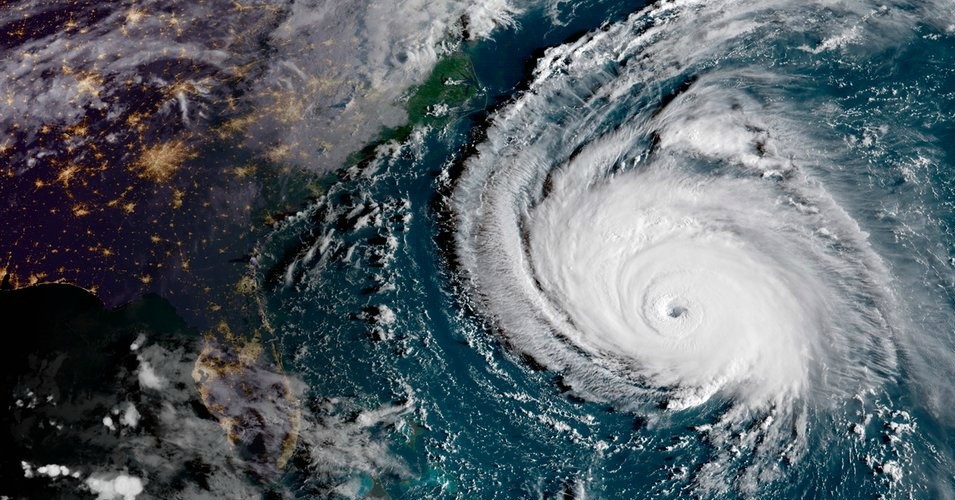As new pathway of storm predicted, National Hurricane Center calls looming storm “very large and incredibly dangerous”
By Jon Queally, staff writer for Common Dreams. Published 9-12-2018

Satellite image of Hurricane Florence swirling in the Atlantic Ocean as it approaches the U.S. coastline in the early hours of Wednesday morning. (Photo: CIRA/RAAMB)
With reports of skyscraper-likes waves out at sea, the potential for historic coastal surges and rainfall, and severe threats to vulnerable nuclear plants and other industrial waste sites—a behemoth Hurricane Florence is fast-approaching the southeastern U.S. coast on Wednesday as weather experts and emergency management officials intensify their warnings about the dangers the “once-in-a-lifetime” storm poses.
With state governments in South Carolina and North Carolina issuing evacuations along the coast and other potential flood zones, the Federal Emergency Management Agency (FEMA) has said that it is mobilizing for a storm that could knock out power for weeks and lead to the displacement of tens if not hundreds of thousands of residents across multiple states.
The National Weather Service (NWS) in Wilmington, N.C., said Florence “will likely be the storm of a lifetime for portions of the Carolina coast,” in a statement early Wednesday morning. “And that’s saying a lot given the impacts we’ve seen from Hurricanes Diana, Hugo, Fran, Bonnie, Floyd and Matthew.”
At 11:00 AM, the National Hurricane Center (NHC)—which called Florence “very large and incredibly dangerous”—updated the hurricane’s track, saying the storm path had moved slightly southward. While still moving towards the Carolinas it could potentially impact Georgia as well.
During a separate FEMA press conference, the agency’s Associate Administrator for Response and Recovery, Jeff Byard, said the storm’s shift towards the south was not good news for people of the region.
Calling on residents to follow evacuation orders declared by state and local officials, Byard said the hit by hurricane would not be a “glancing blow,” but rather “a Mike Tyson punch to the Carolina coast.” After its initial impact, Byard said the most serious concern will be massive rainfalls that would produce dangerous inland flooding.
It is that flooding, warn public health experts, that could have disastrous consequences if toxic wastes, manure pits from industrial agriculture operations, and other storage facilities are overwhelmed by the waters.
According to the Associated Press:
The heavy rain expected from Hurricane Florence could flood hog manure pits, coal ash dumps and other industrial sites in North Carolina, creating a noxious witches’ brew of waste that might wash into homes and threaten drinking water supplies.
Computer models predict more than 3 feet of rain in the eastern part of the state, a fertile low-lying plain veined by brackish rivers with a propensity for escaping their banks. Longtime locals don’t have to strain their imaginations to foresee what rain like that can do. It’s happened before.
“This one is pretty scary,” Jamie Kruse, director of the Center for Natural Hazards Research at East Carolina University, told AP. “The environmental impacts will be from concentrated animal feeding operations and coal ash pits. Until the system gets flushed out, there’s going to be a lot of junk in the water.”
Frank Holleman, senior attorney at the Southern Environmental Law Center, warned “The coal-ash sites are very vulnerable to this hurricane and any other.”
As Common Dreams reported Tuesday, there is also serious concern about several nuclear plants in the region—with the most serious threat thought to be the Brunswick Nuclear Generating Station that is located near Southport, North Carolina. The Beaumont Enterprise reports:
Predictions from the National Hurricane Center also showed the Brunswick plant to be in an area that could be affected by storm surge — seawater forced inland by the storm’s winds.
The NHC warned that the storm surge could lead to “catastrophic” flash flooding far inland. Rising water levels could leave coastal parts of North Carolina under 9 feet of water, the National Hurricane Center’s director, Ken Graham, told CBS News on Tuesday.
Citing the Nuclear Regulatory Commission (NRC), Reuters reports that the Brunswick station is waterproof up to 22 feet, but weather experts have said that area could see a storm surge that is higher than any in recorded history.
#Florence may produce the heaviest rains of any East Coast hurricane on record, and its storm surge could unfold in some unusual, dangerous ways. https://t.co/ZIfQuIo47T pic.twitter.com/Xe1OEJO6aj
— Weather Underground (@wunderground) September 12, 2018
This work is licensed under a Creative Commons Attribution-Share Alike 3.0 License

